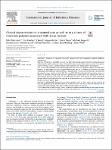Clinical characteristics in a sentinel case as well as in a cluster of tularemia patients associated with grape harvest
Wetzstein, Nils
Kärcher, Iris
Küpper-Tetzel, Claus P.
Kann, Gerrit
Hogardt, Michael
Jozsa, Katalin
Jacob, Daniela
Grunow, Roland
Just-Nübling, Gudrun
Wolf, Timo
Background
Tularemia is caused by Francisella tularensis and can occasionally establish foodborne transmission.
Methods
Patients were identified by active case detection through contact with the treating physicians and consent for publication was obtained. Clinical data were accumulated through a review of the patient charts. Serology, culture, and PCR methods were performed for confirmation of the diagnosis.
Case cluster
A 46-year-old patient was hospitalised in the University Hospital Frankfurt (a tertiary care hospital) for pharyngitis and cervical lymphadenitis with abscess. A diagnosis of tularemia was made serologically, but treatment with ciprofloxacin initially failed. F. tularensis was detected in pus from the lymph node using a specific real-time PCR. The use of RD1 PCR led to the identification of the subspecies holarctica. Antibiotic therapy with high-dose ciprofloxacin and gentamicin was administered and was subsequently changed to ciprofloxacin and rifampicin. During a must-tasting, five other individuals became infected with tularemia by ingestion of contaminated must. All patients required treatment durations of more than 14 days.
Conclusions
Mechanically harvested agricultural products, such as wine must, can be a source of infection, probably due to contamination with animal carcasses. The clinical course of tularemia can be complicated and prolonged and requires differentiated antibiotic treatment.

